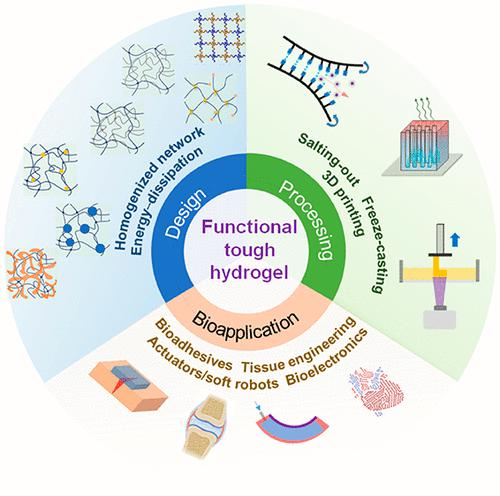当前位置:
X-MOL 学术
›
Acc. Mater. Res.
›
论文详情
Our official English website, www.x-mol.net, welcomes your feedback! (Note: you will need to create a separate account there.)
Functional Tough Hydrogels: Design, Processing, and Biomedical Applications
Accounts of Materials Research ( IF 14.6 ) Pub Date : 2022-11-30 , DOI: 10.1021/accountsmr.2c00026 Xiao Kuang, Mehmet Onur Arıcan, Tao Zhou, Xuanhe Zhao, Yu Shrike Zhang
Accounts of Materials Research ( IF 14.6 ) Pub Date : 2022-11-30 , DOI: 10.1021/accountsmr.2c00026 Xiao Kuang, Mehmet Onur Arıcan, Tao Zhou, Xuanhe Zhao, Yu Shrike Zhang

|
Hydrogels are high-water-content soft materials with widely tunable physicochemical properties, resembling soft tissues. Tremendous progress in engineering hydrogels with good biocompatibility, suitable bioactivities, and controlled geometries has made them promising candidates for broad applications. Nevertheless, conventional hydrogels usually suffer from weak mechanical properties, limiting their use in biomedical settings involving load-bearing and persistent mechanical deformations. Inspired by the extreme mechanical properties and multiscale hierarchical structures of biological tissues, mechanically robust tough hydrogels have been developed. Combining robust mechanical properties and other desired performance characteristics in functional tough hydrogels expands their opportunities in biomedical fields. This Account seeks to guide the readership regarding the recent progress in functional tough hydrogels with a focus on molecular/structural design and novel fabrications, particularly surrounding the works reported by our groups. Meanwhile, functional tough hydrogels for multiple biomedical applications are discussed, highlighting the underlying mechanisms governing their relevant applications. We begin by introducing the definition, measurements, and design principles of tough hydrogels and hydrogel adhesives in terms of soft materials mechanics. Various molecular and structural engineering approaches by building mechanical dissipation into stretchable hydrogels to realize stress homogenization or energy dissipation are exploited to fabricate tough hydrogels. Molecular engineering-based network architecture design of homogeneous hydrogels and structural engineering-based design of heterogeneous hydrogels are elaborated. The conventional energy-dissipation-based tough hydrogels are reinforced by the sacrificial bonds or components, leading to a substantial toughness reduction in subsequent loading cycles. To this end, new molecular designs, including highly entangled hydrogels and sliding-ring hydrogels, have been developed to resolve the toughness–hysteresis conflict. In addition, novel processing techniques, including salting out, freeze casting, and three-dimensional (bio)printing, are exploited to manipulate the multiscale structures and geometries for tough hydrogel fabrication. As some of the most actively studied materials in recent years, functional tough hydrogels are finding promising applications as bioadhesives/coatings, tissue-engineering scaffolds, soft robot/actuators, and bioelectronics interfaces. The development of tough bioadhesives/coatings lies in constructing strong interfacial linkages between the tough hydrogels and the underlying substrates, having broad applications in wound closure and drug delivery. Tough hydrogels have also been widely studied for use in tissue engineering and regenerative medicine, although the conflict of mechanical robustness–cellular function restricts their practical applications. The flexible and compliant tough hydrogels with stimuli-responsive shape shifting and pressure-triggered actuation make them good candidates as actuators and soft robots for biomedical devices dealing with soft tissues. Conductive tough hydrogels also have been widely exploited for utility in bioelectronics. In the end, we highlight the major challenges and emphasize the trends in developing the next-generation functional tough hydrogels for practical biomedical and medical applications.
中文翻译:

功能性坚韧水凝胶:设计、加工和生物医学应用
水凝胶是高含水量的软材料,具有广泛可调的物理化学特性,类似于软组织。具有良好生物相容性、合适的生物活性和受控几何形状的工程水凝胶取得了巨大进步,使其成为广泛应用的有希望的候选者。然而,传统的水凝胶通常具有较弱的机械性能,限制了它们在涉及承重和持久机械变形的生物医学环境中的使用。受生物组织的极端机械性能和多尺度层次结构的启发,已经开发出机械坚固的坚韧水凝胶。在功能性坚韧的水凝胶中结合稳健的机械性能和其他所需的性能特征,扩大了它们在生物医学领域的机会。该帐户旨在引导读者了解功能性坚韧水凝胶的最新进展,重点是分子/结构设计和新型制造,特别是围绕我们小组报告的作品。同时,讨论了用于多种生物医学应用的功能性坚韧水凝胶,强调了控制其相关应用的潜在机制。我们首先从软材料力学的角度介绍坚韧水凝胶和水凝胶粘合剂的定义、测量和设计原则。通过将机械耗散构建到可拉伸水凝胶中以实现应力均匀化或能量耗散的各种分子和结构工程方法被用于制造坚韧的水凝胶。阐述了均质水凝胶的基于分子工程的网络结构设计和异质水凝胶的基于结构工程的设计。传统的基于能量耗散的坚韧水凝胶通过牺牲键或组分增强,导致后续加载循环中的韧性显着降低。为此,已经开发了新的分子设计,包括高度缠结的水凝胶和滑环水凝胶,以解决韧性-滞后冲突。此外,还利用盐析、冷冻铸造和三维(生物)打印等新型加工技术来操纵多尺度结构和几何形状,以制造坚韧的水凝胶。作为近年来研究最活跃的一些材料,功能性坚韧的水凝胶在生物粘合剂/涂层、组织工程支架、软机器人/执行器和生物电子接口等方面具有广阔的应用前景。坚韧的生物粘合剂/涂层的开发在于在坚韧的水凝胶和底层基质之间构建牢固的界面连接,在伤口闭合和药物输送中具有广泛的应用。坚韧的水凝胶也被广泛研究用于组织工程和再生医学,尽管机械强度与细胞功能的冲突限制了它们的实际应用。灵活且柔顺的坚韧水凝胶具有刺激响应变形和压力触发驱动,使其成为处理软组织的生物医学设备的驱动器和软机器人的理想选择。导电坚韧的水凝胶也被广泛用于生物电子学中。最后,我们强调了主要挑战并强调了开发用于实际生物医学和医学应用的下一代功能性坚韧水凝胶的趋势。
更新日期:2022-11-30
中文翻译:

功能性坚韧水凝胶:设计、加工和生物医学应用
水凝胶是高含水量的软材料,具有广泛可调的物理化学特性,类似于软组织。具有良好生物相容性、合适的生物活性和受控几何形状的工程水凝胶取得了巨大进步,使其成为广泛应用的有希望的候选者。然而,传统的水凝胶通常具有较弱的机械性能,限制了它们在涉及承重和持久机械变形的生物医学环境中的使用。受生物组织的极端机械性能和多尺度层次结构的启发,已经开发出机械坚固的坚韧水凝胶。在功能性坚韧的水凝胶中结合稳健的机械性能和其他所需的性能特征,扩大了它们在生物医学领域的机会。该帐户旨在引导读者了解功能性坚韧水凝胶的最新进展,重点是分子/结构设计和新型制造,特别是围绕我们小组报告的作品。同时,讨论了用于多种生物医学应用的功能性坚韧水凝胶,强调了控制其相关应用的潜在机制。我们首先从软材料力学的角度介绍坚韧水凝胶和水凝胶粘合剂的定义、测量和设计原则。通过将机械耗散构建到可拉伸水凝胶中以实现应力均匀化或能量耗散的各种分子和结构工程方法被用于制造坚韧的水凝胶。阐述了均质水凝胶的基于分子工程的网络结构设计和异质水凝胶的基于结构工程的设计。传统的基于能量耗散的坚韧水凝胶通过牺牲键或组分增强,导致后续加载循环中的韧性显着降低。为此,已经开发了新的分子设计,包括高度缠结的水凝胶和滑环水凝胶,以解决韧性-滞后冲突。此外,还利用盐析、冷冻铸造和三维(生物)打印等新型加工技术来操纵多尺度结构和几何形状,以制造坚韧的水凝胶。作为近年来研究最活跃的一些材料,功能性坚韧的水凝胶在生物粘合剂/涂层、组织工程支架、软机器人/执行器和生物电子接口等方面具有广阔的应用前景。坚韧的生物粘合剂/涂层的开发在于在坚韧的水凝胶和底层基质之间构建牢固的界面连接,在伤口闭合和药物输送中具有广泛的应用。坚韧的水凝胶也被广泛研究用于组织工程和再生医学,尽管机械强度与细胞功能的冲突限制了它们的实际应用。灵活且柔顺的坚韧水凝胶具有刺激响应变形和压力触发驱动,使其成为处理软组织的生物医学设备的驱动器和软机器人的理想选择。导电坚韧的水凝胶也被广泛用于生物电子学中。最后,我们强调了主要挑战并强调了开发用于实际生物医学和医学应用的下一代功能性坚韧水凝胶的趋势。

























 京公网安备 11010802027423号
京公网安备 11010802027423号